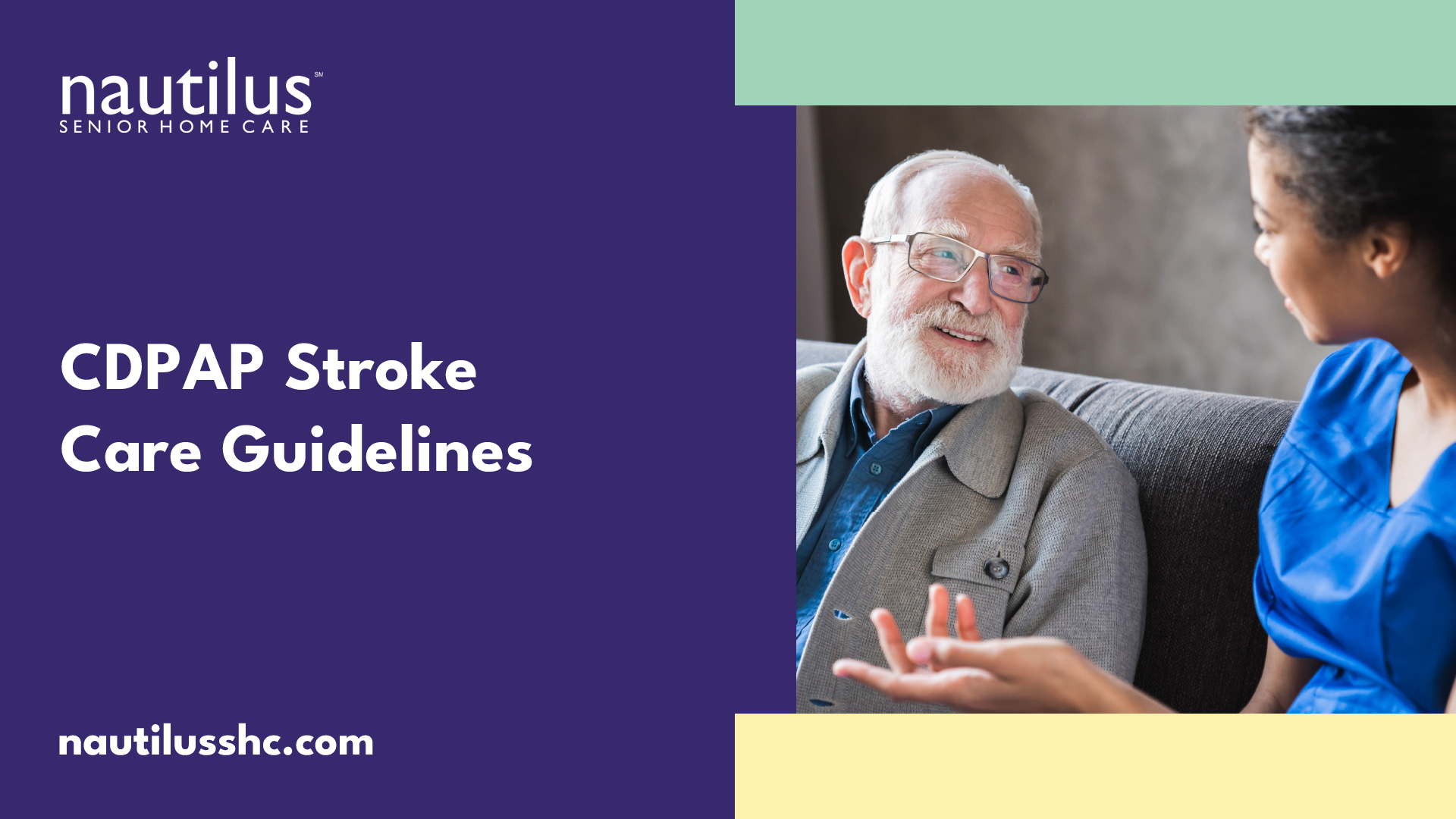Understanding CDPAP Stroke Care
CDPAP (Consumer Directed Personal Assistance Program) stroke care is a specialized form of care provided to individuals who have experienced a stroke. This unique program allows the stroke survivor to choose their own caregiver, often a family member or close friend, who will assist them in their recovery journey. Understanding the fundamentals of CDPAP stroke care is essential for both caregivers and those seeking care.

What is CDPAP?
CDPAP is a Medicaid program that enables individuals with disabilities, including stroke survivors, to have more control over their care by allowing them to hire and direct their own caregivers. This program empowers the individual receiving care to choose someone they trust and feel comfortable with, typically a family member, to provide the necessary assistance.
Through CDPAP, stroke survivors can select their caregivers and take charge of creating a personalized care plan. The caregiver is then trained and compensated for their services, providing support to the stroke survivor in their daily activities, rehabilitation, and overall well-being.
Importance of Stroke Care Plan for CDPAP Caregivers
Having a well-designed stroke care plan is crucial for CDPAP caregivers. A stroke care plan outlines the specific needs, goals, and preferences of the stroke survivor, serving as a roadmap for the caregiver to provide effective care and support. It ensures that the caregiver understands the unique challenges associated with stroke and enables them to provide the necessary assistance and interventions.
A stroke care plan typically includes:
- Activities of Daily Living (ADLs): Assistance with bathing, dressing, grooming, toileting, and other daily activities that the stroke survivor may struggle with.
- Mobility Support and Rehabilitation Exercises: Helping the stroke survivor with mobility, such as walking, transferring, and using assistive devices. The caregiver may also assist in performing prescribed rehabilitation exercises to aid in recovery.
- Communication and Emotional Support: Effective communication strategies are essential for caregivers to understand the stroke survivor’s needs and preferences. Additionally, providing emotional support and creating a supportive environment can positively impact the stroke survivor’s well-being.
- Medication Management: Administering medications as prescribed and keeping track of medication intake is a crucial responsibility for caregivers. It ensures that the stroke survivor receives the right medications at the right time.
- Safety Precautions: Implementing safety measures to prevent falls, making necessary home modifications, and being prepared for emergencies are vital aspects of stroke care.
- Working with Healthcare Professionals: Collaborating with the stroke survivor’s medical team, attending appointments, and regularly monitoring and reporting any changes or concerns to healthcare professionals are essential for effective care.
By understanding the principles of CDPAP stroke care and following the stroke care plan, caregivers can provide the necessary support for stroke survivors, promoting their recovery and overall well-being.
Key Guidelines for Stroke Care
When providing stroke care as a CDPAP caregiver, it is essential to follow key guidelines to ensure the well-being and recovery of the individual. These guidelines focus on early intervention and medical support, assisting with activities of daily living (ADLs), as well as mobility support and rehabilitation exercises.
Early Intervention and Medical Support
Early intervention plays a crucial role in stroke care. As a CDPAP caregiver, it is important to recognize the signs of a stroke and act promptly by seeking medical help. The faster medical support is provided, the better the chances of minimizing potential complications and promoting recovery.
Signs of Stroke
- Sudden numbness or weakness in the face, arm, or leg
- Difficulty speaking or understanding speech
- Sudden confusion or trouble with vision
- Severe headache with no known cause
- Trouble walking or loss of balance
Assisting with emergency medical services and ensuring that the individual receives appropriate medical attention is paramount. Being familiar with emergency contact numbers and having a clear plan in place can help in these critical situations.
Assisting with Activities of Daily Living (ADLs)
Stroke can impact an individual’s ability to perform daily activities independently. As a CDPAP caregiver, providing assistance with activities of daily living (ADLs) is an important aspect of stroke care.
Examples of ADLs
- Bathing
- Dressing
- Eating
- Toileting
- Transferring (moving between bed, chair, etc.)
Understanding the individual’s specific needs and limitations is key to providing effective care. It may involve helping with personal hygiene, dressing, preparing meals, or offering support during mealtimes. Ensuring a safe and comfortable environment is crucial to promote independence and maintain dignity.
Mobility Support and Rehabilitation Exercises
Mobility support and rehabilitation exercises are vital for stroke recovery. As a CDPAP caregiver, you may assist the individual in performing prescribed exercises and activities recommended by healthcare professionals. These exercises can help improve strength, coordination, and overall mobility.
Benefits of Rehabilitation Exercises
- Regaining muscle strength
- Improving balance and coordination
- Enhancing range of motion
- Promoting overall physical well-being
It is important to follow the guidance and instructions provided by the healthcare team when supporting the individual in their rehabilitation journey. Encouraging regular exercise, assisting with mobility aids if necessary, and providing emotional support throughout the process can positively impact the individual’s recovery.
By adhering to these key guidelines for stroke care, CDPAP caregivers can contribute to the well-being and progress of individuals on their stroke recovery journey. Collaboration with healthcare professionals and a focus on early intervention, ADL assistance, and rehabilitation exercises can make a significant difference in achieving the best possible outcomes.
Communication and Emotional Support
Effective communication and emotional support are vital components of providing stroke care through the Consumer Directed Personal Assistance Program (CDPAP). CDPAP caregivers play a crucial role in understanding the needs and emotions of stroke survivors, facilitating their recovery process. This section will explore the key strategies for effective communication and managing emotional well-being.
Effective Communication Strategies
Communication can sometimes be challenging for stroke survivors, as they may experience difficulties with speech, language, or cognition. Here are some effective communication strategies for CDPAP caregivers to employ:
- Be patient and attentive: Give the stroke survivor ample time to express themselves and actively listen to their needs and concerns.
- Use clear and simple language: Speak in a calm and unhurried manner, using short sentences and simple words. Avoid jargon or complex terms that may cause confusion.
- Encourage non-verbal communication: If verbal communication is challenging, encourage the use of gestures, facial expressions, or other non-verbal cues to express thoughts and emotions.
- Provide visual aids: Visual cues, such as pictures, charts, or written instructions, can assist in conveying information and improving understanding.
- Ask open-ended questions: Instead of relying on yes/no questions, ask open-ended questions that encourage the stroke survivor to share their thoughts and feelings.
Remember, effective communication goes beyond verbal interactions. It involves active listening, empathy, and understanding the individual needs and preferences of the stroke survivor.
Managing Emotional Well-being
Stroke recovery is not only physical but also emotional. CDPAP caregivers can provide essential emotional support to stroke survivors by:
- Being empathetic: Show understanding and compassion towards the emotional challenges a stroke survivor may face. Validate their feelings and provide reassurance.
- Encouraging self-expression: Create a safe and non-judgmental environment where the stroke survivor feels comfortable expressing their emotions. Encourage them to share their concerns, fears, or frustrations.
- Offering encouragement and motivation: Recognize and celebrate the stroke survivor’s progress, no matter how small. Provide positive reinforcement and support their goals.
- Helping to establish routines: Establishing daily routines can provide a sense of stability and control, which can positively impact emotional well-being.
- Encouraging participation in support groups: Connect the stroke survivor with local support groups or online communities where they can interact with others who have experienced similar challenges.
By implementing effective communication strategies and providing emotional support, CDPAP caregivers can create a supportive environment that promotes the overall well-being of stroke survivors.
Remember, every stroke survivor is unique, and their communication and emotional support needs may vary. It’s essential to adapt and tailor your approach to meet their individual requirements, ensuring a caring and empathetic caregiving experience.
Medication Management
Administering medications and ensuring proper monitoring and recording of medication intake are crucial components of stroke care within the CDPAP (Consumer Directed Personal Assistance Program). Caregivers play a vital role in helping individuals recovering from a stroke manage their medications effectively.
Administering Medications
Administering medications to stroke patients requires careful attention to detail and adherence to prescribed dosages and schedules. Caregivers should follow these guidelines:
- Dosage Administration: Administer medications as prescribed by the healthcare professional, ensuring the correct dosage is given at the designated times.
- Proper Technique: Use the recommended administration methods, such as oral administration, injection, or topical application, as instructed by the healthcare provider.
- Medication Interactions: Be aware of potential interactions between different medications and consult the healthcare professional if there are any concerns.
- Medication Storage: Store medications in a safe and appropriate manner, following the instructions provided by the healthcare professional or pharmacist.
Monitoring and Recording Medication Intake
Keeping track of medication intake is essential to ensure that stroke patients receive the appropriate medications at the right time. Caregivers should follow these guidelines:
- Medication Schedule: Develop and maintain a medication schedule that outlines the names of the medications, dosages, and specific times they should be administered.
- Timely Administration: Administer medications according to the prescribed schedule, ensuring that doses are not missed or delayed.
- Recording Intake: Keep a detailed record of medication intake, noting the date, time, and dosage administered. This documentation helps track adherence to the medication plan and can be useful for healthcare professionals during follow-up visits.
- Side Effects and Reactions: Monitor for any adverse reactions or side effects from the medications and promptly report them to the healthcare professional.
To assist with organizing medication information and intake records, caregivers can use medication management tools or apps. These tools can help track medication schedules, set reminders, and generate medication intake reports.
By adhering to medication management guidelines, caregivers can ensure stroke patients receive their medications accurately and on time. This plays a vital role in promoting the individual’s recovery and overall well-being.
Safety Precautions
Ensuring the safety of individuals recovering from a stroke is of utmost importance in a CDPAP care setting. Implementing specific safety precautions can help prevent accidents and promote a secure environment for the stroke survivor. Here are three key safety precautions that should be included in the stroke care plan:
Fall Prevention
One of the primary concerns in stroke care is fall prevention. Stroke survivors may experience balance issues, weakness, or difficulty with coordination, which increases their risk of falling. Implementing fall prevention strategies can significantly reduce the likelihood of accidents. Some key fall prevention measures include:
- Keeping the living environment free from clutter and tripping hazards.
- Installing handrails and grab bars in areas such as bathrooms and hallways.
- Using non-slip mats in the bathroom and shower.
- Ensuring proper lighting throughout the home.
- Encouraging the use of assistive devices, such as canes or walkers, as recommended by healthcare professionals.
Home Modifications
Making necessary modifications to the home can enhance safety and accessibility for stroke survivors. These modifications are tailored to meet the specific needs of the individual and may include:
- Installing ramps or lifts to accommodate mobility aids, such as wheelchairs.
- Widening doorways to facilitate easy passage for mobility devices.
- Installing grab bars and handrails in strategic areas for support.
- Removing obstacles and creating clear pathways within the home.
- Ensuring that the home is well-lit, with switches conveniently located.
A thorough evaluation of the living space by a healthcare professional or occupational therapist can provide valuable insights into the necessary home modifications for stroke care.
Emergency Preparedness
Being prepared for emergencies is crucial when caring for a stroke survivor. Caregivers should have a well-defined emergency plan in place to ensure a swift response in case of unforeseen situations. Here are some essential components of emergency preparedness:
- Keeping emergency contact numbers readily available.
- Knowing the location of the nearest hospital and stroke center.
- Having a first aid kit easily accessible.
- Regularly reviewing and updating emergency procedures with the healthcare team.
- Educating caregivers on recognizing stroke warning signs and when to seek immediate medical attention.
Additionally, it is essential for caregivers to be trained in CPR and basic life-saving techniques for emergency situations.
By implementing safety precautions such as fall prevention measures, home modifications, and emergency preparedness, caregivers can create a safe environment for stroke survivors under their care. These precautions, combined with other stroke care guidelines, contribute to a comprehensive and effective stroke care plan within the CDPAP program.
Working with Healthcare Professionals
When it comes to providing stroke care as a CDPAP caregiver, collaboration with healthcare professionals plays a crucial role in ensuring the well-being and recovery of the individual. By working closely with the medical team and following regular health monitoring and reporting practices, caregivers can contribute to a comprehensive and effective stroke care plan.
Collaborating with Medical Team
Collaboration with the medical team is essential for CDPAP caregivers involved in stroke care. By actively participating in discussions and sharing observations, caregivers can contribute valuable insights that aid in the development and adjustment of the care plan. It is important to maintain open lines of communication with healthcare professionals, including doctors, nurses, therapists, and any other specialists involved in the individual’s stroke care.
Regular communication with the medical team allows caregivers to stay updated on the individual’s condition, receive guidance on specific care tasks, and address any concerns or questions that may arise. This collaboration ensures that the care provided aligns with the individual’s unique needs, promotes recovery, and helps manage any potential complications.
Regular Health Monitoring and Reporting
As a CDPAP caregiver, regular health monitoring and reporting are vital aspects of stroke care. By closely observing the individual’s condition and monitoring important health indicators, caregivers can identify any changes or issues that may require immediate attention.
Health monitoring may involve tracking vital signs such as blood pressure, heart rate, and oxygen levels. Caregivers should also be vigilant in observing any changes in the individual’s behavior, mobility, or cognitive abilities. Regularly documenting these observations and communicating them to the medical team helps ensure that appropriate interventions are implemented in a timely manner.
Maintaining accurate records of health monitoring and reporting is crucial. This can be done through the use of a care log or journal, where caregivers can record daily observations, medication administration details, and any concerns or questions they may have. Sharing this information with the medical team during appointments or through regular check-ins allows for a comprehensive understanding of the individual’s progress and helps guide the stroke care plan.
By collaborating with the medical team and prioritizing regular health monitoring and reporting, CDPAP caregivers can play a vital role in supporting the stroke care journey. This collaborative approach ensures that the care provided is comprehensive, tailored to the individual’s needs, and contributes to their overall recovery and well-being.



